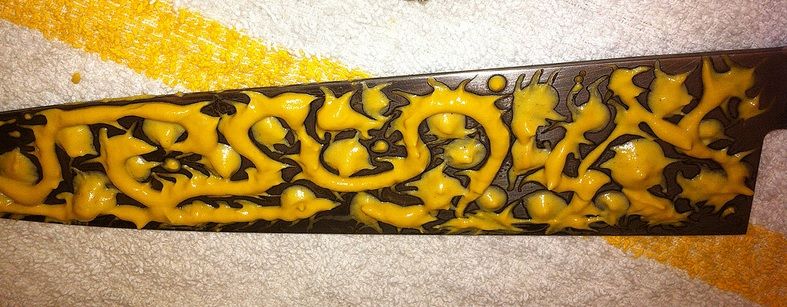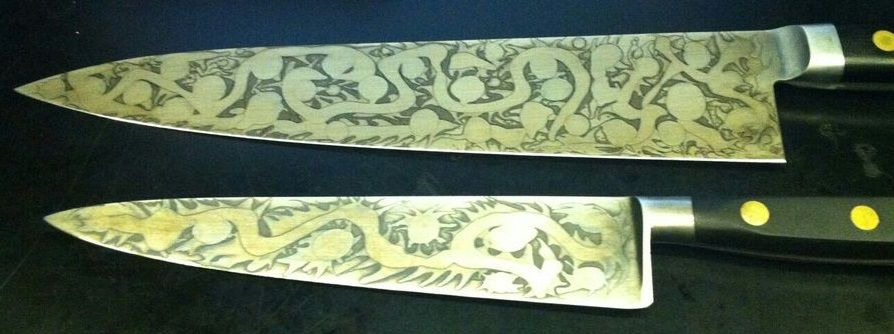Etching Using Mustard / Protecting Carbon Steel
Sept 18, 2015 4:06:54 GMT
Post by Jack Loomes on Sept 18, 2015 4:06:54 GMT
Protecting carbon steel blades using mild acids is a time honoured method of protecting swords and knives from the vicissitudes of time and use. One well known way to achieve a forced patina is to soak the entire blade in watered down vinegar for a day or so, or alternately using lemon juice or other readily available acidic foods. I've even used Diet Cola that I had lying around (I can't stand synthetic sweeteners) The huge advantage of using foods as opposed to substances like muriatic / hydrochloric is not only the safety of using foods, but also (and much less well known) the fact that harsh acids are well known to cause microfractures - Wikipedia Article: Stress Corrosion Cracking
There are many other excellent ways to preserve steel including Gun Blue (which is acidic but stabilised with other chemicals and while not great for your skin will not burn it right off almost instantaneously like muriatic acid does), and also quenching steel from tempering heat (about 400c / 752f) in oil. There are also chemicals available which will blacken steel though these typically require more heat and are more hazardous than Gun Blue.
In terms of safety and convenience however vinegar, mustard and lemon trump more severe enchants for use on swords and knives in my view - why risk your life and the integrity of your blades with super concentrated acids when you don't have to?
It is ofcourse not always possible to get at the blade sans the hilt in order to bath the whole thing in vinegar etc, so what I've done in such instances is soak an old towel which has outlived its usefulness in the bathroom in water, wrung it out, and then saturated it with vinegar. I then wrap the sword blade with the towel, leaving for a few hours at a time (often less than an hour is required depending on the ambient temperature where you are), periodically checking and then rewrapping. You can clip the towel on with clothes pegs for a close fit it you like.
I've long been aware of mustard as an etchant - it contains (depending on the mustard) a number of different acidic ingredients - Wikipedia Article: Mustard - however I'd never really consider using it to create designs. As it turns out it makes an excellent choice (just avoid Mustard that contains salt or you'll be haunted by recurring rust for years after the etch!) for doing exactly that as I discovered while reading Chef Talk, the images provided below show just how effectively it can used with a little creativity:



Image Source: www.cheftalk.com/t/31929/what-kind-of-knife-do-you-have/90
There are many other excellent ways to preserve steel including Gun Blue (which is acidic but stabilised with other chemicals and while not great for your skin will not burn it right off almost instantaneously like muriatic acid does), and also quenching steel from tempering heat (about 400c / 752f) in oil. There are also chemicals available which will blacken steel though these typically require more heat and are more hazardous than Gun Blue.
In terms of safety and convenience however vinegar, mustard and lemon trump more severe enchants for use on swords and knives in my view - why risk your life and the integrity of your blades with super concentrated acids when you don't have to?
It is ofcourse not always possible to get at the blade sans the hilt in order to bath the whole thing in vinegar etc, so what I've done in such instances is soak an old towel which has outlived its usefulness in the bathroom in water, wrung it out, and then saturated it with vinegar. I then wrap the sword blade with the towel, leaving for a few hours at a time (often less than an hour is required depending on the ambient temperature where you are), periodically checking and then rewrapping. You can clip the towel on with clothes pegs for a close fit it you like.
I've long been aware of mustard as an etchant - it contains (depending on the mustard) a number of different acidic ingredients - Wikipedia Article: Mustard - however I'd never really consider using it to create designs. As it turns out it makes an excellent choice (just avoid Mustard that contains salt or you'll be haunted by recurring rust for years after the etch!) for doing exactly that as I discovered while reading Chef Talk, the images provided below show just how effectively it can used with a little creativity:



Image Source: www.cheftalk.com/t/31929/what-kind-of-knife-do-you-have/90

.png?width=1920&height=1080&fit=bounds)